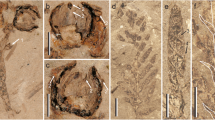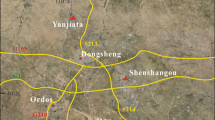Abstract
The epidermis of Pinus mikii leaves was studied. Pinus mikii is a fossil species from the lower Miocene to lower Pleistocene of Japan. In P. mikii, the stomata are closely set and guard cells have polar extensions of cuticle on their inner cell walls. These features suggest that P. mikii is closely related to P. luchuensis, an extant species endemic to the Ryukyu Islands of Japan. Pinus mikii also shares some epidermal characters with P. thunbergii, which is semiendemic to Japan. It is possible that P. mikii is a common ancestor of both of these extant species. The distribution of P. mikii expanded during the Mid-Miocene Climatic Optimum (MMCO), but its distribution shifted southwards as global temperatures declined. Pinus luchuensis likely speciated from the retreating population, whereas P. thunbergii arose from a population that adapted to the cooler climate. This study provides a new perspective on the contribution of MMCO relicts to the floristic diversity of Japan.



Similar content being viewed by others
References
Chinzei K (1986) Faunal succession and geographic distribution of the Neogene molluscan faunas in Japan. In: Kotaka T, Marincovich L Jr (eds) Japanese Cenozoic molluscs—their origin and migration. Palaeontological Society of Japan, special papers, no. 29. Palaeontological Society of Japan, Tokyo, pp 17–32
Debreczy Z, Rácz I (2011) Conifers around the world. DendroPress Ltd., Budapest
Farjon A, Styles BT (1997) Pinus (Pinaceae). Flora neotropica monograph, no. 75. New York Botanical Garden, New York
Fujiki T, Ozawa T (2008) Vegetation change in the main island of Okinawa, southern Japan from late Pliocene to early Pleistocene. Quat Int 184:75–83
Gernandt DS, López GG, García SO, Liston A (2005) Phylogeny and classification of Pinus. Taxon 54:29–42
Ikeda H, Carlsen T, Fujii N, Brochmann C, Setoguchi H (2012) Pleistocene climatic oscillations and the speciation history of an alpine endemic and a widespread arctic-alpine plant. New Phytol 194:583–594
Karasawa H, Nishikawa I (1991) Thalassina anomala (Herbst, 1804) (Thalassinidea: Decapoda) from the Miocene Bihoku group, southwest Japan. Trans Proc Palaeontol Soc Japan 163:852–860
Kato M (2011) Endemic plants of Japan. In: Kato M, Ebihara A (eds) Endemic plants of Japan. A book series from the National Museum of Nature and Science, no. 11. Tokai University Press, Hatano, pp 3–10 (Japanese; original title translated)
Kerp H, Krings M (1999) Light microscopy of cuticules. In: Jones T (ed) Fossil plants and spores: modern techniques. Geological Society, London, pp 52–56
Kim K, Whang SS, Hill RS (1999) Cuticle micromorphology of leaves of Pinus (Pinaceae) in east and south-east Asia. Bot J Linn Soc 129:55–74
Kubota Y, Shiono T, Kusumoto B (2015) Role of climate and geohistorical factors in driving plant richness patterns and endemicity on the east Asian continental islands. Ecography 38:639–648
Kubota Y, Kusumoto B, Shiono T, Tanaka T (2017) Phylogenetic properties of Tertiary relict flora in the east Asian continental islands: imprint of climatic niche conservatism and in situ diversification. Ecography 40:436–447
Matsuo H (1963) Notonakajima Flora of Noto Peninsula. In: Geological Survey of Japan (ed) The collaborating association to commemorate the 80th anniversary of the Geological Survey of Japan Tertiary floras of Japan: Miocene floras. Geological Survey of Japan, Kawasaki, pp 219–243 (245–258, pls. 41–56)
Miki S (1941) On the change of flora in Eastern Asia since Tertiary Period. (I) The clay or lignite beds flora in Japan with special reference to the Pinus trifolia beds in Central Hondo. Jpn J Bot 11:237–303 (pls. 4–7)
Miki S (1957) Pinaceae of Japan, with special reference to its remains. J Inst Polytech Osaka City Univ Ser D 8:221–272 (pls. 1–10)
Miki S, Sakamoto T (1961) Neogene flora from Sasazu in Toyama Prefecturte, Japan. Professor Jiro Makiyama memorial volume, pp 259–264 [pls. 1, 2 (in Japanese with English abstract)]
Milne RI, Abbott RJ (2002) The origin and evolution of tertiary relict floras. Adv Bot Res 38:281–314
Mittermeier RA, Gil PR, Hoffman M, Pilgrim J, Brooks T, Mittermeier CG, Lamoreux J, da Fonseca GAB (2005) Hotspots revisited: Earth’s biologically richest and most endangered terrestrial ecoregions. University of Chicago Press, Chicago
Nakayama K, Todo Collaborative Research Group (1989) Sedimentary basins of the Seto Group. Earth Sci (Chikyu Kagaku) 43:40–49 (in Japanese with English abstract)
Nishida S, Itokazu Y (1976) A palynological study of the Shimajiri Group, Nansei Islands. Mar Sci/mo (Gekkan Kaiyo) 8:57–62 (Japanese with English abstract)
Ogasawara K, Takano M, Nagato H, Nakano T (2008) Cenozoic molluscan faunas and climatic changes in the northern Pacific related to Pacific gateways: review and perspective. Bull Geol Surv Japan 59:355–364
Parks M, Cronn R, Liston A (2012) Separating the wheat from the chaff: mitigating the effects of noise in a plastome phylogenomic data set from Pinus L. (Pinaceae). BMC Evol Biol 12:100
Saladin B, Leslie AB, Wüest RO, Litsios G, Conti E, Salamin N, Zimmermann NE (2017) Fossils matter: improved estimates of divergence times in Pinus reveal older diversification. BMC Evol Biol 17:95
Saneyoshi M, Nakayama K, Tsukagoshi M (2000) Depositional processes of plant material assemblages in fluvial sediments: examples from the plant megafossils in Miocene Tokiguchi Porcelain Clay Formation at Onada mine in Tajimi, central Japan. Earth Sci (Chikyu Kagaku) 54:127–143 (Japanese with English abstract)
Suharyanto, Shiraishi S (2011) Nucleotide diversities and genetic relationship in the three Japanese pine species; Pinus thunbergii, Pinus densiflora, and Pinus luchuensis. Diversity 3:121–135
Takahashi K, Matsumoto Y (1964) Pollenanalyse der Kohlen aus der Yaeyama-Schichtengruppe der Iriomote Insel von der Yaeyama-Inselgruppe. In: Reports of the Committee on Foreign Scientific Research, Kyushu University (second report of the Kyushu University expedition to the Yaeyama Group, Ryukyus), offprint, vol 2. Kyushu Univ, Fukuoka, pp 35–46 (Japanese with German abstract)
Tanai T (1961) Neogene floral change in Japan. J Fac Sci Hokkaido Univ Ser 4 Geol Mineral 11:119–398
Tanai T (1967) Tertiary floral changes of Japan. In: Jubilee Publication in the commemoration of Professor Yasuo Sasa, Dr. Sc. 60th Birthday. Jubilee Committee of Professor Yasuo Sasa, Dr. Sc. 60th Birthday, Sapporo, pp 317–334
Tanai T (1991) Tertiary climatic and vegetational changes in the Northern Hemisphere. J Geogr 100:951–966 (Japanese with English abstract)
Tanai T (1992) Tertiary vegetational history of East Asia. Bull Mizunami Fossil Mus 19:125–163 (Japanese with English abstract)
Tiffney BH (1985) Perspectives on the origin of the floristic similarity between eastern Asia and eastern North America. J Arnold Arbor 66:73–94
Tsuda K, Itoigawa J, Yamanoi T (1986) Mangrove swamp fauna and flora in the Middle Miocene of Japan. In: Kotaka T, Marincovich L Jr (eds) Japanese Cenozoic Molluscs—their origin and migration. Palaeontological Society of Japan, Special Papers, no. 29. Palaeontological Society of Japan, Tokyo, pp 129–134
Uemura K (1986) Late Miocene Plants from Onbara in Northern Okayama Pref., Southwestern Honshu, Japan. Bull Nat Sci Mus Tokyo Ser C 12:121–130
Ujiié H (1994) Early Pleistocene birth of the Okinawa Trough and Ryukyu Island Arc at the northwestern margin of the Pacific: evidence from Late Cenozoic planktonic foraminiferal zonation. Palaeogeogr Palaeoclimatol Palaeoecol 108:457–474
Wang XR, Tsumura Y, Yoshimaru H, Nagasaka K, Szmidt AE (1999) Phylogenetic relationships of Eurasian pines (Pinus, Pinaceae) based on chloroplast rbcL, matK, rpl20-rps18 spacer, and trnV intron sequences. Amer J Bot 86:1742–1753
Wolfe JA (1975) Some aspects of plant geography in the northern hemisphere during the late Cretaceous and Tertiary. Ann Mo Bot Gard 62:264–279
Yamada M, Yamada T (2017) Ovuliferous scale anatomies of Pinus species and their value for classification above the species level. Bot J Linn Soc 183:633–643
Yamada T, Yamada M, Tsukagoshi M (2014) Fossil records of subsection Pinus (genus Pinus, Pinaceae) from the Cenozoic in Japan. J Plant Res 127:193–208
Yamada T, Yamada M, Tsukagoshi M (2015) Taxonomic revision of Pinus fujiii (Yasui) Miki (Pinaceae) and its implication for the phytogeography of the Section Trifoliae in East Asia. PLoS One 10: e0143512. doi:https://doi.org/10.1371/journal.pone.0143512
Yamanoi T, Tsuda K (1986) On the conditions of Paleo-Mangrove forest in the Kurosedani Formation (Middle Miocene), Central Japan. Mem Nat Sci Mus Tokyo 19:55–66 (Japanese with English abstract)
Yasui K (1928) Studies on the structure of lignite, brown coal, and bituminous coal in Japan. J Fac Sci Imp Univ Tokyo Sect 3 Bot 3:381–468 (pls. 9–24)
Zachos J, Pagani M, Sloan L, Thomas E, Billups K (2001) Trends, rhythms, and aberrations in global climate 65 Ma to present. Science 292:686–693
Acknowledgements
We thank the Kamigamo Experimental Station, Field Science Education and Research Center, Kyoto University, and K. Yamahira for providing leaf samples. M. Tsukagoshi kindly helped us to register the microscope slides and fossils used in this study.
Author information
Authors and Affiliations
Corresponding author
Rights and permissions
About this article
Cite this article
Yamada, M., Yamada, T. Relicts of the Mid-Miocene Climatic Optimum may contribute to the floristic diversity of Japan: a case study of Pinus mikii (Pinaceae) and its extant relatives. J Plant Res 131, 239–244 (2018). https://doi.org/10.1007/s10265-017-0993-6
Received:
Accepted:
Published:
Issue Date:
DOI: https://doi.org/10.1007/s10265-017-0993-6




